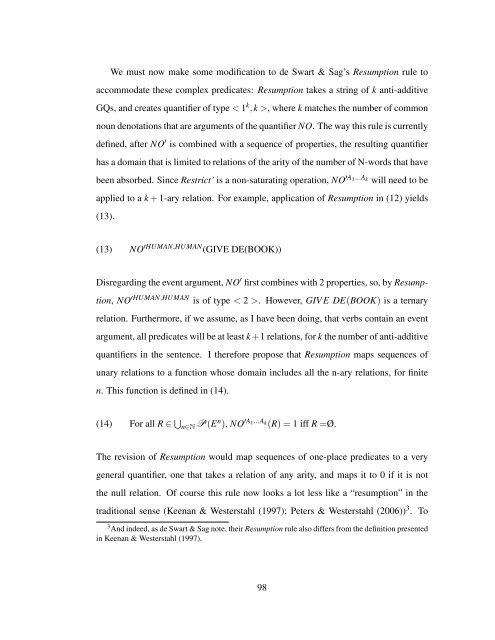Formal Approaches to Semantic Microvariation: Adverbial ...
Formal Approaches to Semantic Microvariation: Adverbial ...
Formal Approaches to Semantic Microvariation: Adverbial ...
You also want an ePaper? Increase the reach of your titles
YUMPU automatically turns print PDFs into web optimized ePapers that Google loves.
We must now make some modification <strong>to</strong> de Swart & Sag’s Resumption rule <strong>to</strong><br />
accommodate these complex predicates: Resumption takes a string of k anti-additive<br />
GQs, and creates quantifier of type < 1 k ,k >, where k matches the number of common<br />
noun denotations that are arguments of the quantifier NO. The way this rule is currently<br />
defined, after NO ′ is combined with a sequence of properties, the resulting quantifier<br />
has a domain that is limited <strong>to</strong> relations of the arity of the number of N-words that have<br />
been absorbed. Since Restrict’ is a non-saturating operation, NO ′A 1...A k will need <strong>to</strong> be<br />
applied <strong>to</strong> a k + 1-ary relation. For example, application of Resumption in (12) yields<br />
(13).<br />
(13) NO ′HUMAN,HUMAN (GIVE DE(BOOK))<br />
Disregarding the event argument, NO ′ first combines with 2 properties, so, by Resumption,<br />
NO ′HUMAN,HUMAN is of type < 2 >. However, GIV E DE(BOOK) is a ternary<br />
relation. Furthermore, if we assume, as I have been doing, that verbs contain an event<br />
argument, all predicates will be at least k+1 relations, for k the number of anti-additive<br />
quantifiers in the sentence. I therefore propose that Resumption maps sequences of<br />
unary relations <strong>to</strong> a function whose domain includes all the n-ary relations, for finite<br />
n. This function is defined in (14).<br />
(14) For all R ∈ ⋃ n∈N P(E n ), NO ′A 1...A k (R) = 1 iff R =Ø.<br />
The revision of Resumption would map sequences of one-place predicates <strong>to</strong> a very<br />
general quantifier, one that takes a relation of any arity, and maps it <strong>to</strong> 0 if it is not<br />
the null relation. Of course this rule now looks a lot less like a “resumption” in the<br />
traditional sense (Keenan & Westerstahl (1997); Peters & Westerstahl (2006)) 3 . To<br />
3 And indeed, as de Swart & Sag note, their Resumption rule also differs from the definition presented<br />
in Keenan & Westerstahl (1997).<br />
98
















